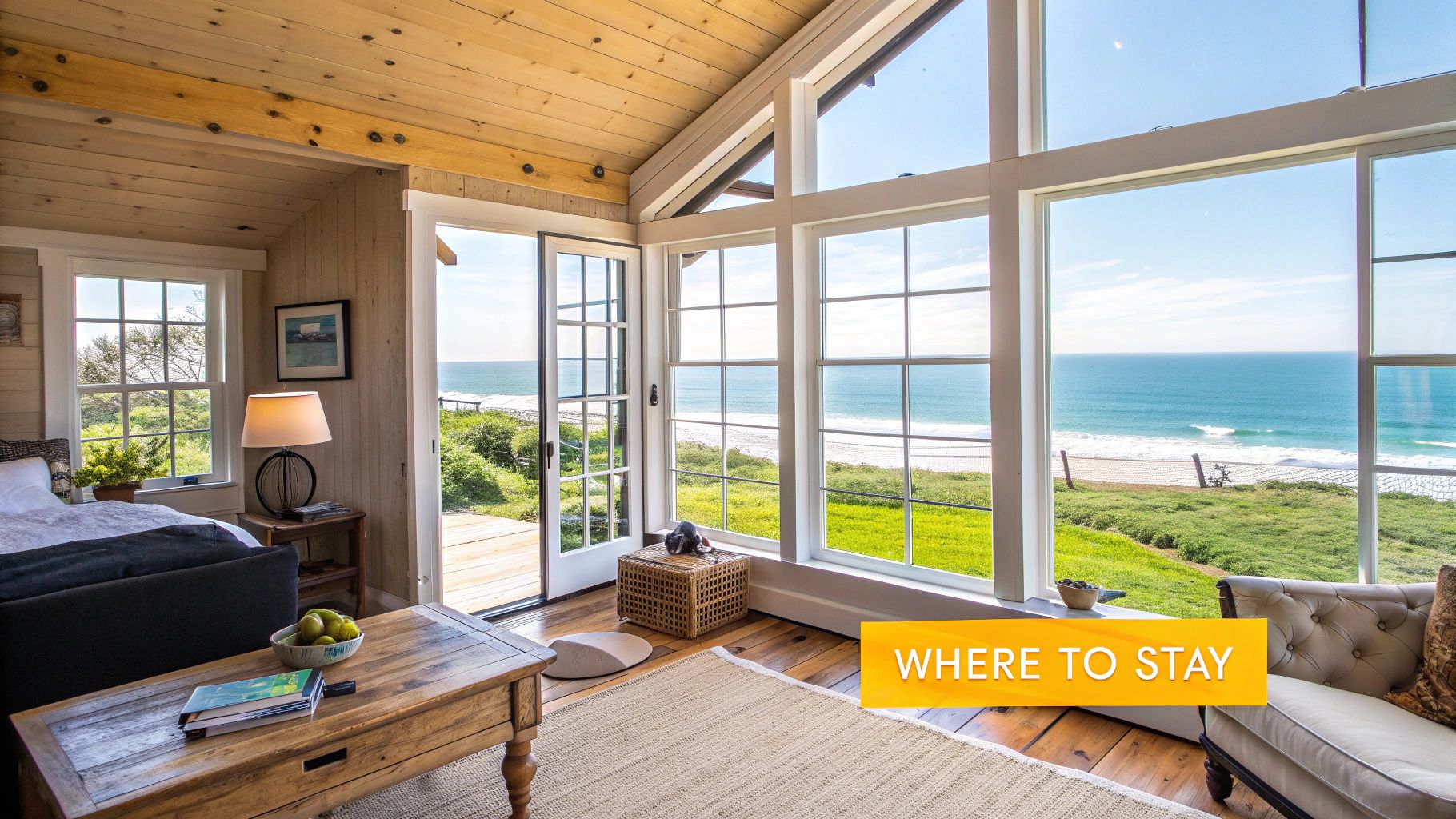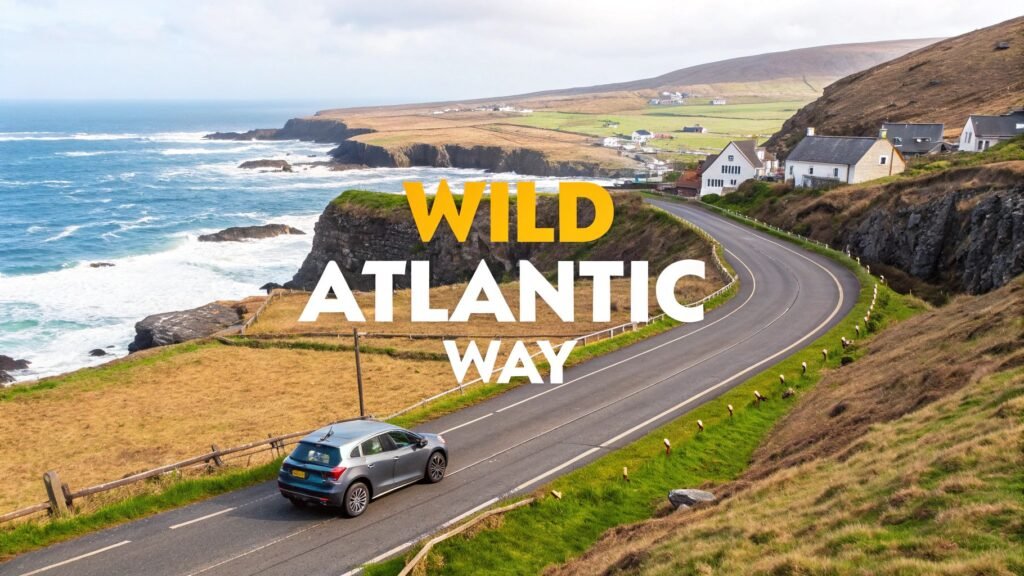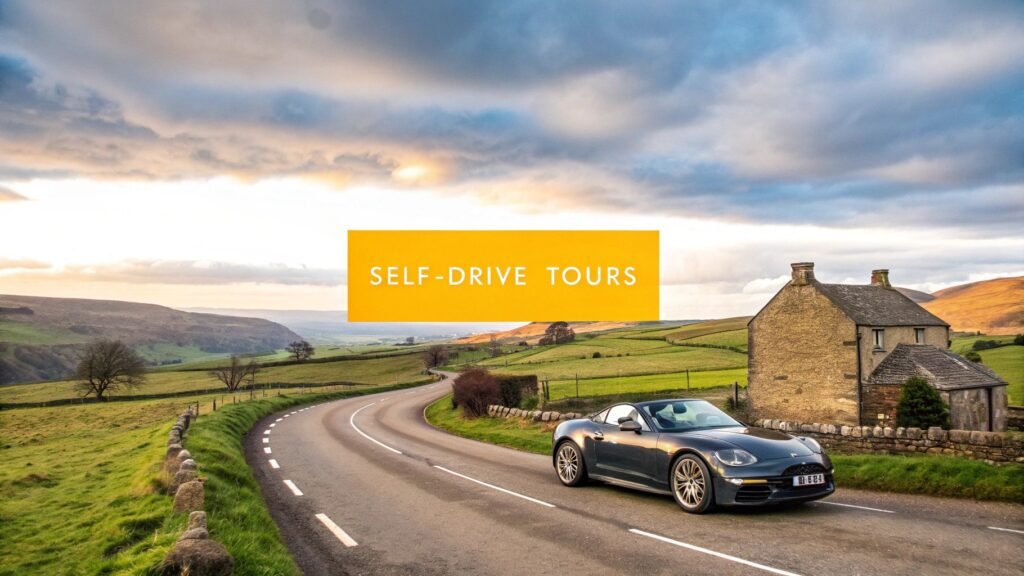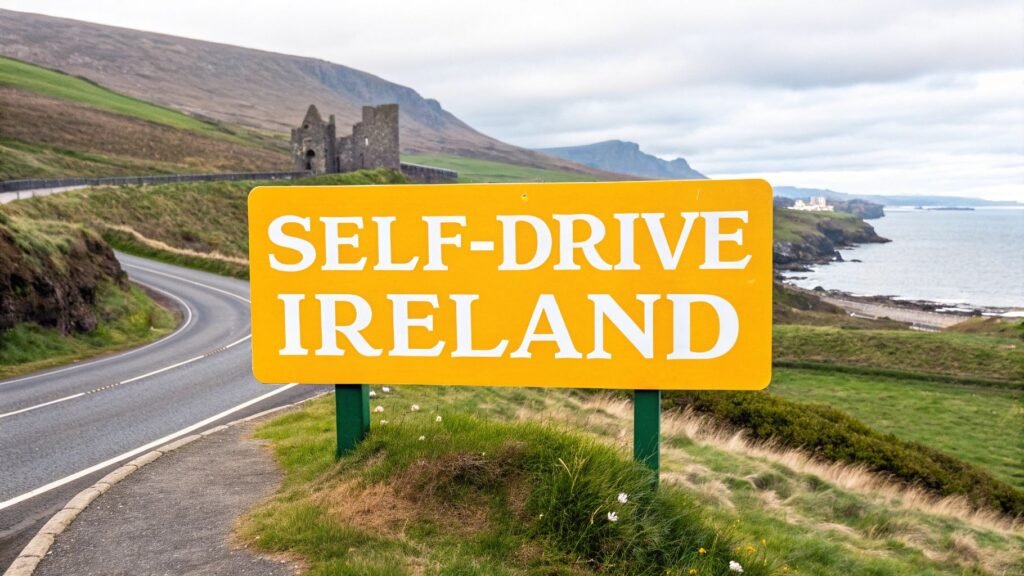A journey along the Wild Atlantic Way isn’t just a road trip; it’s a 2,500 km odyssey that gets you right to the heart and soul of Ireland. This Wild Atlantic Way itinerary is your ticket to a world of dramatic cliffs, windswept beaches, and villages bursting with colour and character. Starting from the wild northern headlands of Donegal all the way down to the charming harbours of Cork, you’re not just seeing the country—you’re experiencing its raw beauty and rich culture firsthand.
Why This Irish Road Trip Is So Iconic
The Wild Atlantic Way is far more than just a line on a map. It’s been thoughtfully designed to guide you into the very fabric of coastal Ireland. This isn’t your standard point-A-to-point-B drive; it’s a deep dive into breathtaking landscapes, ancient history, and the genuine warmth of the local communities you’ll meet along the way. It offers a sense of freedom and discovery that’s increasingly rare.
What really makes it special is the incredible mix of world-famous landmarks and quiet, undiscovered corners. One moment you could be standing in awe at the top of the majestic Cliffs of Moher, and the next, you might find yourself in a tiny, traditional pub, sipping a quiet pint while live music fills the room. It’s this constant dance between the grand and the intimate that lodges the experience so firmly in your memory.
More Than Just a Scenic Drive
Officially launched back in 2014, the route was a brilliant initiative to showcase Ireland’s stunning west coast. It created a single, continuous touring path that now brings in around one million visitors each year. The strategy worked, successfully drawing tourism beyond the usual hotspots, injecting new life into smaller towns, and helping to stretch the traditional tourist season. You can read more about the project’s vision in this Fáilte Ireland regional strategy report.
The real magic of this journey is its authenticity. It’s an open invitation to wander at your own pace and build an adventure that’s truly yours, whether you’re chasing historical sites, stunning nature, or incredible food.
Thankfully, the entire route is brilliantly signposted with distinctive blue and white markers, so you can spend less time staring at a map and more time gazing at the jaw-dropping scenery. To get a fuller picture of what this epic drive involves, take a look at our complete guide to the Wild Atlantic Way in Ireland.
To help you get your bearings before you start planning, let’s break down the main regions you’ll be travelling through.
Wild Atlantic Way Regions at a Glance
This table gives you a quick snapshot of the different sections of the route, the counties they pass through, and some of the unmissable highlights in each. It’s the perfect starting point for figuring out which areas you want to focus on.
| Region | Counties Covered | Key Highlights |
|---|---|---|
| Northern Headlands | Donegal | Slieve League Cliffs, Fanad Head, Malin Head |
| Surf Coast | Donegal, Sligo, Mayo | Surfing in Bundoran, Céide Fields, Mullaghmore Head |
| Bay Coast | Galway, Mayo | Killary Harbour, Connemara, Achill Island |
| Cliff Coast | Clare, Galway | Cliffs of Moher, The Burren, Aran Islands |
| Southern Peninsulas | Kerry, Cork | Ring of Kerry, Dingle Peninsula, Skellig Michael |
| Haven Coast | Cork | Kinsale, Mizen Head, Beara Peninsula |
Each of these regions has its own distinct personality and charm. Whether you choose to tackle the entire 2,500 km route or just dip into one or two sections, you’re guaranteed an unforgettable adventure.
How to Plan Your Self-Drive Adventure

Turning the dream of an Irish road trip into a reality is all about the planning. A bit of foresight before you go means your Wild Atlantic Way itinerary will be memorable for the breathtaking views and spontaneous detours, not for last-minute panics over where you’re sleeping that night.
The very first thing to decide is when you want to go. The time of year you choose will shape everything from daylight hours and crowds to the overall feel of your adventure.
Picking the Best Time to Travel
While the long, sunny days of summer are tempting, you’ll be sharing the experience with plenty of other visitors and paying peak-season prices for the privilege. From my experience, the sweet spot is often just outside this main rush.
- Spring (April-May): This is when the Irish countryside truly awakens. The landscape is a vibrant green, newborn lambs dot the fields, and the days are getting noticeably longer. You’ll find the roads and popular spots far less crowded.
- Autumn (September-October): The landscape shifts to rich, rusty hues, and there’s a wonderful crispness in the air. The summer crowds have thinned out, but nearly all the pubs, restaurants, and attractions are still open and buzzing.
Winter can be magical, but it’s not for the faint of heart. You’ll have to contend with much shorter days and a real chance of wild, stormy weather, which can make driving on those exposed coastal roads a serious challenge.
No matter which season you pick, remember the golden rule of packing for Ireland: prepare for all four seasons in a single day. A good waterproof jacket, a few warm layers, and solid, comfortable shoes are absolutely essential.
Choosing Your Vehicle and Budgeting
The car you choose can genuinely make or break your trip. I know the appeal of a big, comfortable car, especially for families, but a smaller vehicle is a godsend on the narrow, winding lanes that define so much of this route. Trust me, you’ll be grateful for it when you meet a tractor on a single-track road!
When you’re renting, look very closely at the insurance policy. Irish car hire can have some specific quirks, so understanding the collision damage waiver (CDW) and your options before you get to the rental desk will save you a lot of hassle.
Beyond the car, a realistic budget is key to a relaxing journey.
Estimated Daily Costs (per person):
- Fuel: £25–£40 (this really depends on your car and how much ground you cover)
- Accommodation: £70–£150 (from cosy B&Bs to more upmarket hotels)
- Food: £40–£60 (for a mix of hearty pub lunches and supermarket snacks)
- Attractions: £15–£30 (many natural sights are free, but castles and experiences have entry fees)
These are just ballpark figures, of course, and you can easily adjust them to fit your own style. If you’d rather have someone else handle the logistics, you can explore our range of customisable self-drive tours where we sort the route and accommodation for you. For inspiration on structuring your own journey, looking at different self-drive itinerary ideas can also spark some great approaches to planning your route.
A Flexible 10-Day Wild Atlantic Way Itinerary
Right, this is where the real adventure begins to unfold. Forget about those minute-by-minute, rigid schedules. This Wild Atlantic Way itinerary is built for how people actually travel, giving you a solid framework for 10 days while leaving plenty of room to chase that unexpected signpost or linger a bit longer over a great view.
I’ve broken the journey into manageable chunks, pointing out the absolute must-sees, a few hidden gems I’ve found over the years that most tourists drive right past, and some personal tips for genuinely memorable stops. Think of this not as a strict set of rules, but as your road map, drawn by someone who’s been there, for crafting an Irish road trip you’ll never forget.
Days 1-2: The Northern Headlands
Your journey kicks off in the raw, untamed splendour of County Donegal. This is a land of sheer cliffs that plunge into the Atlantic, wind-battered peninsulas, and a powerful sense of quiet that feels a million miles from anywhere.
- Scenic Route: Get started on the Inishowen Peninsula and make your way to Malin Head, which is Ireland’s most northerly point. The coastal roads up here are definitely narrow, but the staggering views are more than worth it.
- Must-See Sights: You absolutely cannot miss the Slieve League Cliffs. They’re nearly three times higher than the more famous Cliffs of Moher but get just a fraction of the visitors, making the experience feel much more personal. Fanad Head Lighthouse is another essential stop for that postcard-perfect photo.
- Overnight Stay: I’d recommend basing yourself in a town like Donegal Town or the craft-hub of Ardara for two nights. It gives you a full day to explore without the hassle of packing and unpacking every single day.
Days 3-4: The Surf and Bay Coasts
As you leave Donegal behind, you’ll meander south into County Sligo and County Mayo. This part of the coast is legendary for its powerful Atlantic swells that draw surfers from all over the world, but it’s also steeped in ancient history and dotted with peaceful bays.
You’ll find a bit of everything here. One minute you could be watching the pros ride the waves at Bundoran, and the next you could be contemplating the ancient mystery of the Céide Fields, a vast Neolithic landscape preserved for millennia under a blanket of bog. It’s a coastline of brilliant contrasts.

This simple approach helps you find a good rhythm, balancing your time behind the wheel with actually getting out and seeing things. You never want to feel like you’re just rushing from point to point.
Days 5-6: The Cliff Coast and The Burren
Now you’re heading into the very heart of the Wild Atlantic Way, a region defined by two of Ireland’s most spectacular landscapes: the mighty Cliffs of Moher and the strange, lunar-like terrain of The Burren. Prepare for views that will genuinely stop you in your tracks.
My best piece of advice for the Cliffs of Moher is to go either very early in the morning or later in the afternoon. You’ll completely sidestep the crush of tour bus crowds and get to see the cliffs bathed in the beautiful, soft light of dawn or dusk.
After the cliffs, give yourself plenty of time to explore The Burren. It’s a completely unique limestone pavement, home to an incredible mix of rare flowers and ancient stone dolmens. For lunch, pull into Doolin, a village famous for its traditional Irish music sessions.
You’ll notice the quality of the visitor experiences here. Fáilte Ireland, our national tourism authority, is investing heavily to boost the Wild Atlantic Way’s global appeal. This means better facilities at places like Dún Aonghasa, new trails in Connemara National Park, and smart viewing points that improve the experience while protecting the landscape.
Days 7-8: The Southern Peninsulas
Welcome to County Kerry, home to some of the most famous scenery in all of Ireland. This part of your Wild Atlantic Way itinerary loops you around the stunning Dingle Peninsula and the iconic Ring of Kerry.
While the Ring of Kerry gets all the fame, many people (myself included) find the Slea Head Drive on the Dingle Peninsula even more spectacular and intimate. The drive is a tight loop that practically clings to the coastline, offering up unbelievable views of the Blasket Islands.
- Insider Tip: Always drive the Slea Head Drive clockwise. The road is incredibly narrow in spots, and going this direction keeps you on the inside lane (away from the drop!) and, crucially, moving with the same flow as the tour buses.
- Overnight Stay: The buzzing town of Dingle is the perfect base for this region. Its colourful streets are packed with fantastic pubs, great little shops, and some of the best seafood you’ll ever eat.
Days 9-10: The Haven Coast
Your final stretch takes you through the lush landscapes of West Cork to the official end of the route in Kinsale. This is a gentler, softer coastline characterised by wooded inlets, sheltered fishing harbours, and thriving artistic communities.
Make sure you drive the scenic route out to Mizen Head, Ireland’s most southwesterly point. Walking across that iconic bridge to the signal station, with the Atlantic churning below, is a brilliant experience. Your journey concludes in the beautiful harbour town of Kinsale, which has rightly earned its title as the “Gourmet Capital of Ireland.” Treat yourself to a celebratory meal at one of its many incredible restaurants—you’ve earned it
Beyond the Driver’s Seat: Truly Authentic Irish Experiences

Let’s be honest, a great Wild Atlantic Way itinerary is about more than just the drive. While the coastal roads are spectacular, the memories that really stick are made when you step out of the car and dive into the heart of Irish life.
It’s these moments—a windswept hike, a foot-stomping music session, a taste of just-caught seafood—that transform a brilliant road trip into a proper adventure. This is your chance to swap the driver’s seat for a front-row view of what makes the West of Ireland so utterly captivating.
Embrace the Wild Outdoors
The raw beauty you see whizzing past your car window is ten times more powerful when you experience it up close. Getting active, whether on foot or on the water, is the best way to feel the pulse of the Atlantic coast.
- Hike the Dingle Peninsula: The trails winding around Slea Head are legendary for a reason. You’ll find paths for every ability, each offering some of the most dramatic coastal views in all of Ireland.
- Take a Boat Trip to Skellig Michael: Whether you’re a Star Wars fan or a history lover, visiting this otherworldly UNESCO World Heritage site is unforgettable. Be warned: trips are weather-dependent and you absolutely must book months in advance.
- Surf the Waves in Lahinch: County Clare is a magnet for surfers. Don’t worry if you’re a complete novice; taking a lesson at Lahinch is a thrilling way to get a feel for the Atlantic’s energy.
These aren’t just activities to fill an afternoon; they’re your opportunity to become part of the very landscape you came to see.
Find an Authentic Trad Session
One of the most magical things you can do in Ireland is wander into a pub and find a traditional music session in full swing. This isn’t a staged performance for visitors; it’s the real deal—a living, breathing part of the local culture.
The best sessions are rarely advertised. As you wander through towns like Doolin, Dingle, or Galway in the evening, just keep your ears open. Follow the sound of a fiddle or a flute spilling from a pub doorway, grab a pint, and soak up the incredible atmosphere.
You’ll see musicians of all ages sharing tunes passed down through generations. It’s an informal, electric, and genuinely Irish experience that perfectly sums up the spirit of the west coast.
Savour the Local Flavours
The food scene along the Wild Atlantic Way has become a destination in its own right, built on world-class local ingredients and the passion of its producers.
Forget just eating in restaurants; get your hands dirty. Try something truly unique like a seaweed foraging walk on the coast of Clare, where you’ll discover the edible treasures of the shoreline. You could also visit a local smokehouse to taste incredible Irish salmon or drop into one of the many farmhouse cheesemakers you’ll find along the route.
If you’re a real foodie and want to build your trip around these amazing tastes, you might want to look at a specially designed culinary self-drive tour of Ireland.
Getting Behind the Wheel: A Few Pointers for Driving in Ireland

Driving is the heart and soul of any Wild Atlantic Way itinerary, but let’s be honest—it’s not always a walk in the park. Knowing what you’re getting into before you even pick up the keys is the best way to ensure your road trip is memorable for all the right reasons.
First off, the big one: we drive on the left side of the road here. If that’s new to you, it’ll feel a bit odd for the first hour, but you’ll get the hang of it faster than you think. My best piece of advice? Book a smaller, automatic car. You’ll be grateful for its nimble size on those tight country lanes, and it frees you up from worrying about changing gears with your “other” hand.
Getting to Grips with Narrow Roads
Many of the most breathtaking roads on this route are, to put it mildly, snug. You’ll find yourself on lanes barely wide enough for one car, let alone two, often bordered by ancient stone walls or thick hedgerows that leave zero margin for error.
When you inevitably meet another car, it becomes a little dance. One of you will need to tuck into a designated pull-in point or find a slightly wider spot to let the other pass.
There’s an unwritten rule of the road here: whoever has the easiest and safest spot to pull in does so. It’s a game of patience and courtesy, and a simple wave to say thanks goes a long way. It’s just part of the local driving culture.
Another tip from experience: take your GPS’s time estimates with a huge grain of salt. If it claims a 50-mile trip will take an hour, you should probably budget for at least 50% longer. Between the winding roads, irresistible photo opportunities, and the occasional flock of sheep deciding to cross, the journey itself is the destination.
This slower, more immersive style of travel is becoming more popular. While overall visitor numbers can fluctuate, recent trends show people are staying longer, which is perfect for a leisurely road trip. You can dig into some of the official Irish tourism statistics if you’re curious.
Reading the Signs and Watching for Hazards
Thankfully, Irish road signs are pretty straightforward. Just remember that distances are posted in kilometres (km), and speed limits are in kilometres per hour (km/h). Keep an eye out for the distinctive blue signs with the wavy Wild Atlantic Way logo—they’ll keep you pointed in the right direction.
One last thing: mind your fuel tank. Petrol stations can become surprisingly scarce in the beautifully remote stretches of Donegal, Mayo, and Kerry.
A Quick Checklist Before You Drive:
- Don’t rush it: The slow pace is part of the experience. Relax and enjoy the view.
- Stay left: This is crucial, especially when navigating roundabouts and tricky junctions.
- Watch for surprises: Sheep, cows, and tractors are as common as other cars on rural roads.
- Fill ‘er up: If you spot a petrol station in a remote area, it’s always a good idea to top up, even if you’re not on empty.
Your Wild Atlantic Way Questions Answered
https://www.youtube.com/embed/EutNb1VnyBA
Even with the best-laid plans, a few last-minute questions always seem to surface just before a big trip. Getting those final details ironed out for your Wild Atlantic Way itinerary can make all the difference, turning a good holiday into a great one.
Think of this as your final pre-flight check before you get behind the wheel. I’ll cover the most common queries I hear, drawing from my own trips along the coast to give you practical, road-tested advice. We’ll look at timing, what to drive, and which direction to point the car.
How Many Days Do You Really Need?
This is always the million-dollar question. To be honest, to truly do justice to the entire 2,500 km route without constantly clock-watching, you’d want at least two full weeks. That kind of timeframe gives you the freedom to linger, take that intriguing detour you just spotted, and actually get out of the car to soak it all in.
But I know most of us don’t have that luxury.
A 7 to 10-day trip is a fantastic and much more realistic goal. It gives you a brilliant taste of the journey’s magic. You can cover a really iconic stretch—say, from the epic cliffs of Clare up to the rugged wilds of Donegal—and feel like you’ve had a proper adventure, not just a mad dash.
Is a Campervan a Good Idea?
I get the appeal, I really do. The thought of pulling up your campervan to a jaw-dropping coastal view is a powerful one. The reality on the ground, however, can be a bit more complicated. Many of the most beautiful and rewarding roads on the Wild Atlantic Way are incredibly narrow, winding lanes flanked by ancient stone walls. There’s very little room for manoeuvre.
A campervan is absolutely possible, but you need to be a very confident driver who’s comfortable with tight squeezes. Be prepared to navigate some challenging roads and accept that you might have to skip the smaller, more restrictive routes. For most people, a small or medium-sized car is simply less stressful and offers much more flexibility.
Which Direction Should I Drive?
Officially, the route runs north to south, kicking off in Donegal and winding its way down to Cork. The big advantage of driving it this way is that the Atlantic is always on your right-hand side. This puts you on the correct side of the road for uninterrupted views and easy pull-ins at scenic lookouts. It’s the recommended direction for a reason.
That said, there’s no rule book. Driving from south to north (Cork to Donegal) is perfectly fine and has its own perks. You might find you’re going against the main flow of tour bus traffic, which can be a real bonus on popular sections like the Ring of Kerry. In the end, it boils down to what makes the most sense for your flights and personal preference.
At BTOURS, we specialise in crafting unforgettable self-drive journeys that let you discover the real Ireland at your own pace. Explore our curated tours and start planning your adventure today.



